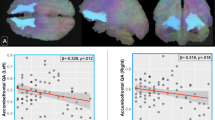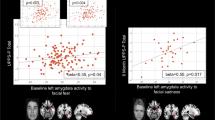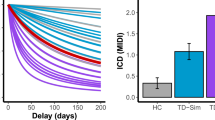Abstract
Reinforcement-related cognitive processes, such as reward processing, inhibitory control and social–emotional regulation are critical components of externalising and internalising behaviours. It is unclear to what extent the deficit in each of these processes contributes to individual behavioural symptoms, how their neural substrates give rise to distinct behavioural outcomes and whether neural activation profiles across different reinforcement-related processes might differentiate individual behaviours. We created a statistical framework that enabled us to directly compare functional brain activation during reward anticipation, motor inhibition and viewing emotional faces in the European IMAGEN cohort of 2,000 14-year-old adolescents. We observe significant correlations and modulation of reward anticipation and motor inhibition networks in hyperactivity, impulsivity, inattentive behaviour and conduct symptoms, and we describe neural signatures across cognitive tasks that differentiate these behaviours. We thus characterise shared and distinct functional brain activation patterns underling different externalising symptoms and identify neural stratification markers, while accounting for clinically observed comorbidity.
This is a preview of subscription content, access via your institution
Access options
Access Nature and 54 other Nature Portfolio journals
Get Nature+, our best-value online-access subscription
$29.99 / 30 days
cancel any time
Subscribe to this journal
Receive 12 digital issues and online access to articles
$119.00 per year
only $9.92 per issue
Buy this article
- Purchase on Springer Link
- Instant access to full article PDF
Prices may be subject to local taxes which are calculated during checkout



Similar content being viewed by others
Data availability
IMAGEN data are available from a dedicated database: https://imagen2.cea.fr.
Code availability
Custom code that supports the findings of this study is available from the corresponding author upon request.
References
Castellanos, F. X., Sonuga-Barke, E. J., Milham, M. P. & Tannock, R. Characterizing cognition in ADHD: beyond executive dysfunction. Trends Cogn. Sci. 10, 117–123 (2006).
Blanken, L. M. et al. Cognitive functioning in children with internalising, externalising and dysregulation problems: a population-based study. Eur. Child Adolesc. Psychiatry 26, 445–456 (2017).
Shakoor, S., McGuire, P., Cardno, A. G., Freeman, D. & Ronald, A. A twin study exploring the association between childhood emotional and behaviour problems and specific psychotic experiences in a community sample of adolescents. J. Child Psychol. Psychiatry 59, 565–573 (2018).
Schumann, G. et al. The IMAGEN study: reinforcement-related behaviour in normal brain function and psychopathology. Mol. Psychiatry 15, 1128–1139 (2010).
Chen, J. E. & Glover, G. H. Erratum to: functional magnetic resonance imaging methods. Neuropsychol. Rev. 25, 314 (2015).
Nymberg, C. et al. Neural mechanisms of attention-deficit/hyperactivity disorder symptoms are stratified by MAOA genotype. Biol. Psychiatry 74, 607–614 (2013).
Dalley, J. W. & Robbins, T. W. Fractionating impulsivity: neuropsychiatric implications. Nat. Rev. Neurosci. 18, 158–171 (2017).
Schultz, W. Neuronal reward and decision signals: from theories to data. Physiol. Rev. 95, 853–951 (2015).
Aron, A. R., Robbins, T. W. & Poldrack, R. A. Inhibition and the right inferior frontal cortex: one decade on. Trends Cogn. Sci. 18, 177–185 (2014).
Quinlan, E. B. et al. Psychosocial stress and brain function in adolescent psychopathology. Am. J. Psychiatry 174, 785–794 (2017).
Adolphs, R. Cognitive neuroscience of human social behaviour. Nat. Rev. Neurosci. 4, 165–178 (2003).
Jia, T. et al. Neural basis of reward anticipation and its genetic determinants. Proc. Natl Acad. Sci. USA 113, 3879–3884 (2016).
Gerdes, A. B. et al. Emotional sounds modulate early neural processing of emotional pictures. Front. Psychol. 4, 741 (2013).
Serences, J. T. Value-based modulations in human visual cortex. Neuron 60, 1169–1181 (2008).
Pleger, B., Blankenburg, F., Ruff, C. C., Driver, J. & Dolan, R. J. Reward facilitates tactile judgments and modulates hemodynamic responses in human primary somatosensory cortex. J. Neurosci. 28, 8161–8168 (2008).
Salimpoor, V. N. et al. Interactions between the nucleus accumbens and auditory cortices predict music reward value. Science 340, 216–219 (2013).
Goodman, A., Lamping, D. L. & Ploubidis, G. B. When to use broader internalising and externalising subscales instead of the hypothesised five subscales on the strengths and difficulties questionnaire (SDQ): data from British parents, teachers and children. J. Abnorm. Child Psychol. 38, 1179–1191 (2010).
Mumford, J. A. et al. Detecting network modules in fMRI time series: a weighted network analysis approach. Neuroimage 52, 1465–1476 (2010).
Vinod, H. D. Canonical ridge and econometrics of joint production. J. Econometrics 4, 147–166 (1976).
Knutson, B., Fong, G. W., Adams, C. M., Varner, J. L. & Hommer, D. Dissociation of reward anticipation and outcome with event-related fMRI. Neuroreport 12, 3683–3687 (2001).
Bari, A. & Robbins, T. W. Inhibition and impulsivity: behavioral and neural basis of response control. Prog. Neurobiol. 108, 44–79 (2013).
Grosbras, M. H. & Paus, T. Brain networks involved in viewing angry hands or faces. Cereb. Cortex 16, 1087–1096 (2006).
Langfelder, P., Zhang, B. & Horvath, S. Defining clusters from a hierarchical cluster tree: the Dynamic Tree Cut package for R. Bioinformatics 24, 719–720 (2008).
Bartels, M. et al. Childhood aggression and the co-occurrence of behavioural and emotional problems: results across ages 3–16 years from multiple raters in six cohorts in the EU-ACTION project. Eur. Child Adolesc. Psychiatry 27, 1105–1121 (2018).
Kuhfeld, W. F. A note on Roy’s largest root. Psychometrika 51, 479–481 (1986).
Lakens, D. Equivalence tests: a practical primer for t tests, correlations, and meta-analyses. Soc. Psychol. Personal Sci. 8, 355–362 (2017).
Cohen, J. Statistical Power Analysis for the Behavioral Sciences (L. Erlbaum Associates, 1988).
Krueger, R. F. et al. Progress in achieving quantitative classification of psychopathology. World Psychiatry 17, 282–293 (2018).
Cuthbert, B. N. & Insel, T. R. Toward the future of psychiatric diagnosis: the seven pillars of RDoC. BMC Med. 11, 126 (2013).
Pas, P., van den Munkhof, H. E., du Plessis, S. & Vink, M. Striatal activity during reactive inhibition is related to the expectation of stop-signals. Neuroscience 361, 192–198 (2017).
Fox, P. T. & Friston, K. J. Distributed processing; distributed functions? Neuroimage 61, 407–426 (2012).
Robinson, J. L., Laird, A. R., Glahn, D. C., Lovallo, W. R. & Fox, P. T. Metaanalytic connectivity modeling: delineating the functional connectivity of the human amygdala. Hum. Brain Mapp. 31, 173–184 (2010).
Logothetis, N. K. What we can do and what we cannot do with fMRI. Nature 453, 869–878 (2008).
Li, J. et al. Primary auditory cortex is required for anticipatory motor response. Cereb. Cortex 27, 3254–3271 (2017).
Mountcastle, V. B., Lynch, J. C., Georgopoulos, A., Sakata, H. & Acuna, C. Posterior parietal association cortex of the monkey: command functions for operations within extrapersonal space. J. Neurophysiol. 38, 871–908 (1975).
Rubia, K., Smith, A. B., Brammer, M. J. & Taylor, E. Temporal lobe dysfunction in medication-naive boys with attention-deficit/hyperactivity disorder during attention allocation and its relation to response variability. Biol. Psychiatry 62, 999–1006 (2007).
Swanson, J. M. et al. Etiologic subtypes of attention-deficit/hyperactivity disorder: brain imaging, molecular genetic and environmental factors and the dopamine hypothesis. Neuropsychol. Rev. 17, 39–59 (2007).
Hobson, C. W., Scott, S. & Rubia, K. Investigation of cool and hot executive function in ODD/CD independently of ADHD. J. Child Psychol. Psychiatry 52, 1035–1043 (2011).
Scheres, A., Oosterlaan, J. & Sergeant, J. A. Response inhibition in children with DSM-IV subtypes of AD/HD and related disruptive disorders: the role of reward. Child Neuropsychol. 7, 172–189 (2001).
Burke, J. D., Waldman, I. & Lahey, B. B. Predictive validity of childhood oppositional defiant disorder and conduct disorder: implications for the DSM-V. J. Abnorm. Psychol. 119, 739–751 (2010).
Spencer, T., Biederman, J. & Wilens, T. Attention-deficit/hyperactivity disorder and comorbidity. Pediatr. Clin. North Am. 46, 915–927 (1999).
Jensen, P. S., Martin, D. & Cantwell, D. P. Comorbidity in ADHD: implications for research, practice, and DSM-V. J. Am. Acad. Child Adolesc. Psychiatry 36, 1065–1079 (1997).
Heidbreder, R. ADHD symptomatology is best conceptualized as a spectrum: a dimensional versus unitary approach to diagnosis. Atten. Defic. Hyperact. Disord. 7, 249–269 (2015).
Whelan, R. et al. Adolescent impulsivity phenotypes characterized by distinct brain networks. Nat. Neurosci. 15, 920–925 (2012).
Goodman, R. Psychometric properties of the strengths and difficulties questionnaire. J. Am. Acad. Child Adolesc. Psychiatry 40, 1337–1345 (2001).
Herjanic, B. & Reich, W. Development of a structured psychiatric interview for children: agreement between child and parent on individual symptoms. J. Abnorm. Child Psychol. 25, 21–31 (1997).
Goodman, R., Ford, T., Richards, H., Gatward, R. & Meltzer, H. The development and well-being assessment: description and initial validation of an integrated assessment of child and adolescent psychopathology. J. Child Psychol. Psychiatry 41, 645–655 (2000).
Ernst, M. et al. Choice selection and reward anticipation: an fMRI study. Neuropsychologia 42, 1585–1597 (2004).
Cooney, R. E., Atlas, L. Y., Joormann, J., Eugene, F. & Gotlib, I. H. Amygdala activation in the processing of neutral faces in social anxiety disorder: is neutral really neutral? Psychiatry Res. 148, 55–59 (2006).
Passamonti, L. et al. Neural abnormalities in early-onset and adolescence-onset conduct disorder. Arch. Gen. Psychiatry 67, 729–738 (2010).
Pardini, D. A. & Phillips, M. Neural responses to emotional and neutral facial expressions in chronically violent men. J. Psychiatry Neurosci. 35, 390–398 (2010).
Gan, G. et al. Alcohol-induced impairment of inhibitory control is linked to attenuated brain responses in right fronto-temporal cortex. Biol. Psychiatry 76, 698–707 (2014).
Langfelder, P. & Horvath, S. WGCNA: an R package for weighted correlation network analysis. BMC Bioinformatics 9, 559 (2008).
Combes, S. et al. Relationships between sensory and physicochemical measurements in meat of rabbit from three different breeding systems using canonical correlation analysis. Meat Sci. 80, 835–841 (2008).
Leurgans, S. E., Moyeed, R. A. & Silverman, B. W. Canonical correlation-analysis when the data are curves. J. R. Stat. Soc. B Met. 55, 725–740 (1993).
Sherry, A. & Henson, R. K. Conducting and interpreting canonical correlation analysis in personality research: a user-friendly primer. J. Pers. Assess. 84, 37–48 (2005).
Efron, B. & Stein, C. The jackknife estimate of variance. Ann. Stat. 9, 586–596 (1981).
Bulik-Sullivan, B. et al. An atlas of genetic correlations across human diseases and traits. Nat. Genet. 47, 1236–1241 (2015).
Fisher, R. A. On the probable error of a coefficient of correlation deduced from a small sample. Metron 1, 3–32 (1921).
Dunn, O. J. & Clark, V. Correlation coefficients measured on the same individuals. J. Am. Stat. Assoc. 64, 366–377 (1969).
Steiger, J. H. Tests for comparing elements of a correlation matrix. Psychol. Bull. 87, 245–251 (1980).
Meng, X.-L., Rosenthal, R. & Rubin, D. B. Comparing correlated correlation coefficients. Psychol. Bull. 111, 172–175 (1992).
Lumley, T., Diehr, P., Emerson, S. & Chen, L. The importance of the normality assumption in large public health data sets. Annu. Rev. Public Health 23, 151–169 (2002).
Acknowledgements
This work received support from the following sources: the European Union-funded FP6 Integrated Project IMAGEN (reinforcement-related behaviour in normal brain function and psychopathology; LSHM-CT-2007-037286), the Horizon 2020-funded ERC Advanced Grant ‘STRATIFY’ (brain network-based stratification of reinforcement-related disorders; 695313), National Natural Science Foundation of China (81801773 and 81873909), the Shanghai Pujiang Project (18PJ1400900), ERANID (understanding the interplay between cultural, biological and subjective factors in drug use pathways; PR-ST-0416-10004), BRIDGET (JPND brain imaging, cognition, dementia and next generation GEnomics; MR/N027558/1), the Human Brain Project (SGA 2, 785907, and SGA 3, 945539), the FP7 project MATRICS (603016), the Medical Research Council Grant ‘c-VEDA’ (consortium on vulnerability to externalizing disorders and addictions; MR/N000390/1), the National Institute of Health (NIH) (R01DA049238, A decentralized macro and micro gene-by-environment interaction analysis of substance use behavior and its brain biomarkers), the National Institute for Health Research Biomedical Research Centre at South London and Maudsley NHS Foundation Trust and King’s College London, the Bundesministerium für Bildung und Forschung (grants 01GS08152 and 01EV0711 and Forschungsnetz AERIAL 01EE1406A and 01EE1406B), the Deutsche Forschungsgemeinschaft (DFG grants SM 80/7-2, SFB 940, TRR 265 and NE 1383/14-1), the Medical Research Foundation and Medical Research Council (grants MR/R00465X/1 and MR/S020306/1), the National Institutes of Health (NIH)-funded ENIGMA (grants 5U54EB020403-05 and 1R56AG058854-01). Further support was provided by grants from: ANR ANR-12-SAMA-0004, AAPG2019 - GeBra), the Eranet Neuron (AF12-NEUR0008-01 - WM2NA and ANR-18-NEUR00002-01 - ADORe), the Fondation de France (00081242), the Fondation pour la Recherche Médicale (DPA20140629802), the Mission Interministérielle de Lutte Contre les Drogues et les Conduites Addictives (MILDECA), the Assistance-Publique – Hôpitaux de Paris and INSERM (interface grant), Paris Sud University IDEX 2012, the Fondation de l’Avenir (grant AP-RM-17-013), the Fédération pour la Recherche sur le Cerveau, the National Institutes of Health, Science Foundation Ireland (16/ERCD/3797) and U.S.A. (Axon, Testosterone and Mental Health during Adolescence; RO1 MH085772-01A1), and by NIH Consortium grant U54 EB020403 (supported by a cross-NIH alliance that funds Big Data to Knowledge Centres of Excellence), the 111 Project (B18015), the National Key Research and Development Program of China (2018YFC0910503 and 2018YFC1312900), the NSFC (81930095 and 91630314), The Key Project of Shanghai Science and Technology Innovation Plan (16JC1420402), the Shanghai Municipal Science and Technology Major Project (2018SHZDZX01) and Zhangjiang Lab. The funders had no role in study design, data collection and analysis, decision to publish or preparation of the manuscript.
Author information
Authors and Affiliations
Consortia
Contributions
G.S. and T.J. designed the study. T.J. and G.S. wrote the manuscript. A.I., E.B.Q., N.T., Q.L. and B.F. edited the first draft. All authors critically reviewed the manuscript. T.B., G.J.B., A.L.W.B., U.B., C.B., S.D., J.F., H.F., A.G., H.G., P.G., A.H., B.I., J.-L.M., M.-L.P.M., F.N., T.P., L.P., J.H.F., M.N.S., H.W., R.W. and G.S. were the principal investigators. E.B.Q., T.B., G.J.B., A.L.W.B., U.B., C.B., H.F., A.G., H.G., P.G., A.H., B.I., J.-L.M., M.-L.P.M., F.N., D.P.O., T.P., L.P., J.H.F., M.N.S., H.W., R.W. and G.S. acquired the data. T.J. and A.I. analysed the data.
Corresponding authors
Ethics declarations
Competing interests
T.B. served in an advisory or consultancy role for Lundbeck, Medice, Neurim Pharmaceuticals, Oberberg and Shire. He received conference support or speaker’s fees from Lilly, Medice, Novartis and Shire. He has been involved in clinical trials conducted by Shire and Vifor Pharma. He received royalties from Hogrefe, Kohlhammer, CIP Medien and Oxford University Press. The present work is unrelated to the above grants and relationships. G.J.B. has received honoraria from General Electric Healthcare for teaching on scanner programming courses. The other authors declare no competing interests.
Additional information
Publisher’s note Springer Nature remains neutral with regard to jurisdictional claims in published maps and institutional affiliations.
Editor recognition statement: Primary Handling Editor: Marike Schiffer.
Extended data
Extended Data Fig. 1 Dendrograms of heirachical clustering for WVCNA nodes.
Dendrogram trees and static cut at 90% quantile of height of branches for (A) MID, (B) SST and (C) EFT nodes from WVCNA.
Extended Data Fig. 2 Overlapped functional brain regions.
Overlapped Functional Brain Regions (Cohen’s D > 0.30) Identified across All Three Tasks.
Extended Data Fig. 3 Extended RCCA results between fMRI and externalizing behaviours.
RCCA results between fMRI and externalising behaviours based on 1000 Permutation with predefined Regulation Parameters: A. The Effect Size (η2) and Confidence Intervals; B. P-values.
Extended Data Fig. 4 Extended RCCA results between fMRI and internalizing behaviours.
RCCA results between fMRI and internalising behaviours based on 1000 Permutation with predefined regulation parameters.
Extended Data Fig. 5 The design of monetary incentive delay (MID) task.
The figure of experimental paradigm was adapted from a previous publication6.
Extended Data Fig. 6 The design of emotional face task (EFT).
The figure of experimental paradigm was adapted from a previous publication22.
Extended Data Fig. 7 The design of stop signal task (SST).
The figure of experimental paradigm was adapted from a previous publication52.
Extended Data Fig. 8 Plot of soft-threshold for MID (A), EFT (B) and SST (C).
The soft-thresholds were picked as 7 for MID, 8 for EFT and 7 for SST.
Supplementary information
Supplementary Information
Supplementary Tables 2–4 and the full list of consortium members.
Supplementary Table 1
a, Functional brain regions identified through WVCNA for the MID task and the following hierarchical clustering results at the height of the top 90%. b, Functional brain regions identified through WVCNA for the SST task and the following hierarchical clustering results at the height of the top 90%. c, Functional brain regions identified through WVCNA for the EFT task and the following hierarchical clustering results at the height of the top 90%
Rights and permissions
About this article
Cite this article
Jia, T., Ing, A., Quinlan, E.B. et al. Neurobehavioural characterisation and stratification of reinforcement-related behaviour. Nat Hum Behav 4, 544–558 (2020). https://doi.org/10.1038/s41562-020-0846-5
Received:
Accepted:
Published:
Issue Date:
DOI: https://doi.org/10.1038/s41562-020-0846-5
This article is cited by
-
Evaluating the development and well-being assessment (DAWBA) in pediatric anxiety and depression
Child and Adolescent Psychiatry and Mental Health (2024)
-
Brain imaging of a gamified cognitive flexibility task in young and older adults
Brain Imaging and Behavior (2024)
-
Neurophysiological stratification of major depressive disorder by distinct trajectories
Nature Mental Health (2023)
-
A general neuropsychopathological factor underlying many mental illnesses
Nature Medicine (2023)
-
A shared neural basis underlying psychiatric comorbidity
Nature Medicine (2023)



